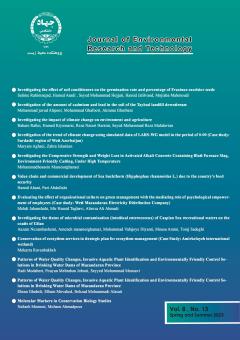-
-
-
Open Access Article
1 - Evaluation of the efficiency of the advanced aerobic process by the Moving bed bioreactor (MBBR) method in wastewater treatment of detergent production industries
saeed poorkareem Fariba Ostovar Kamran TaghaviAbstract In this study, the aerobic biological process was investigated by the moving bed bioreactor (MBBR) method for wastewater treatment of detergent industries. The mean of COD and LAS in raw wastewater were 10231 mg/L and 210 mg/L, respectively. In this study, th MoreAbstract In this study, the aerobic biological process was investigated by the moving bed bioreactor (MBBR) method for wastewater treatment of detergent industries. The mean of COD and LAS in raw wastewater were 10231 mg/L and 210 mg/L, respectively. In this study, three different concentrations of LAS (210, 500, and 1000 mg/L) were used to determine the efficiency of the whole system in removing COD and LAS. The BOD5/COD ratio increased from 0.2 in raw wastewater to 0.45 after pretreatment. In the MBBR system in reactor 1 with 36 hours of hydraulic rate time (HRT), the highest removal efficiencies of 93.41% and 95% were obtained for COD and LAS, respectively. In Reactor 2 with similar conditions to HRT of 36 hours, the highest removal efficiencies for COD and LAS were 94.20% and 99.99%, respectively. By changing the amount of injected air from 30 L/min to 50 L/min and then 70 L/min, the removal efficiency in the amount of air injected about 50 L/min was increased. Organic charge loading (OUR) studies also showed a reduction in specific oxygen consumption from about 11 mg O2/gr MLSS.hr at the beginning of the operation period to about 2 mg O2/gr MLSS.hr at the end of the period. This study showed that the MBBR process, can meet the environmental output standards for the treatment of detergent industry wastewater and be used as an efficient method in detergent industry wastewater treatment. Manuscript profile -
Open Access Article
2 - Feasibility Study of Denitrification of Drinking Water Using Photocatalytic Substrate over Ultra-High Performance Concrete
Sama Tajasosi Jalil Barandoust Ramazan Vagheei Fariba Ostovar saeed poorkareemDenitrification of drinking water has a research history of more than three decades in the field of water treatment and is still the subject of many research projects. The main purpose of this study is to obtain or modify methods for removing nitrate from drinking water MoreDenitrification of drinking water has a research history of more than three decades in the field of water treatment and is still the subject of many research projects. The main purpose of this study is to obtain or modify methods for removing nitrate from drinking water in an economic way and force minimal adverse effects on the environment. The use of photocatalytic process for denitrification is not new, but there are still many ambiguities. In this study, the feasibility of using two different photocatalysts over the ultra-high performance concrete (UHPC) substrate was discussed. This new substrate is fabricated by immobilizing the photocatalyst inside a cement matrix which acts as an active layer over the UHPC surface. Optimum long-term lifecycle and higher efficiency of this active surface is achieved without a significant drop of the photocatalyst activity near the surface. In this study, the possibility of using photocatalytic composite layers over the elements made of UHPC for applications such as water supply channels was evaluated and the challenges of using such layers on UHPC surfaces were described. According to the studies, it was found that the use of fixed cement composite bed for photocatalytic treatment has advantages over other methods of photocatalytic water treatment. Manuscript profile
List of Articles Fariba Ostovar
-
The rights to this website are owned by the Raimag Press Management System.
Copyright © 2017-2024


